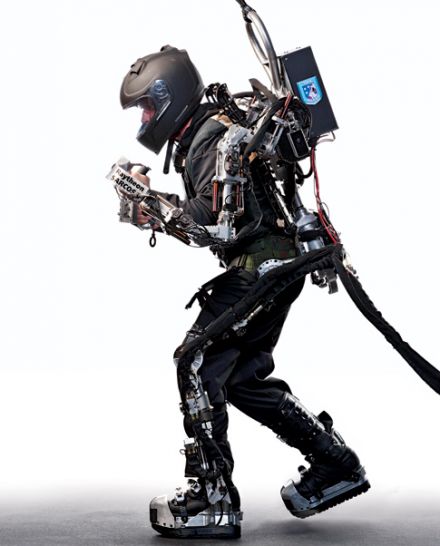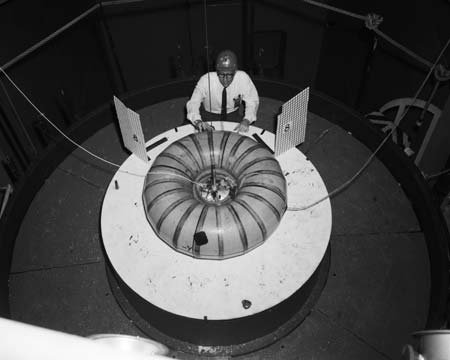Cyborg Uprising Part 3: The Non-Committal Cyborg
 Now that we have defined in Part 1 what a cyborg is and established that the computer processing power is available in Part 2, it’s time to start creating a cyborg. First off, we’ll look at bionics that don’t require any sort of surgery or implantation. Think of it as transhumanism for those with commitment issues. We’re looking more at the Iron Man type here. This includes the likes of War Machine, Rocket Red, M.A.N.T.I.S., and Super Force as well. (Am I the only one who even remembers the shows M.A.N.T.I.S. and Super Force?) Whether a person is disabled or simply had too much free time on their hands and built an awesome piece of machinery to run around as a super-powered, costumed vigilante (which I probably would do if I had the resources), can it be done using current technology?
Now that we have defined in Part 1 what a cyborg is and established that the computer processing power is available in Part 2, it’s time to start creating a cyborg. First off, we’ll look at bionics that don’t require any sort of surgery or implantation. Think of it as transhumanism for those with commitment issues. We’re looking more at the Iron Man type here. This includes the likes of War Machine, Rocket Red, M.A.N.T.I.S., and Super Force as well. (Am I the only one who even remembers the shows M.A.N.T.I.S. and Super Force?) Whether a person is disabled or simply had too much free time on their hands and built an awesome piece of machinery to run around as a super-powered, costumed vigilante (which I probably would do if I had the resources), can it be done using current technology?

The concept of external functional enhancement is nothing new. Humans have been using tools since the days when philosophers began pondering such revolutionary ideas as, “Ooga booga bunga.” The concept of an external device being an extension of the person is one of the primary concepts of ancient martial arts using weapons. The concept of technology enhancing human actions has existed since the idea of the robot came about in the late 19th century. But science fiction has only been able to dream about the possibilities until just recently.
While this type of cyborg shouldn’t technically be limited to a super suit, that is what is thought of the most when thinking about non-implanted cybernetics. I covered the subject fairly well in an earlier article on superheroes. So most of this will probably be review. But there will be a little bit of newer concepts thrown in as well.
First off, let’s look at the basis of what we normally think of as a cyber-suit. This would be a combination of the structure and strength enhancement. Regardless of what nifty little gadgets and additional features are added to various super suits, these two factors tend to be common across all of them. It’s hard to imagine any cybernetic prosthetics that don’t offer some level of armor and strength enhancement. In a world that praises its comic book superheroes, anything less would be a grievous disappointment.
When considering boosting strength there are actually some real world examples of what can be effective. First off is the Cyberdyne HAL 5 which has just recently been approved for medical use. The Japanese company Cyberdyne designed the Hybrid Assistive Limb, called a “robot suit”, for workers in places like nursing homes where they often have to lift residents into baths and such. It is reported to have a lifting ratio of 8:1. Unfortunately, it slows the movement a bit and doesn’t allow for quick movement by foot.
The second thing we can look at is the XOS2 built by defense contractor Raytheon. It uses less power than its predecessor, the XOS, but so far still needs to be tethered for power. But like the first incarnation, it has a whopping 20:1 lifting ratio! To top it all off, it is designed to allow for quick movement over land since, although it is intended for field logistics, it was also made to produce the next generation of super soldier. So the ability for a cyborg to have enhanced strength is definitely there.

No reason to stop there though. Since we’re looking at current science and technology, we might as well look at a different means of providing strength than the servos and motors in the HAL 5 and XOS2. I would say that carbon nanotube muscles would be right up our sci-fi loving alley. Nanotubes are not only known to be extremely strong and resilient (each tube is a single molecule after all), they also contract pretty strongly when given an electrical current. This could potentially provide a more efficient means of strength than motorized joints.
As for armor plating, the single molecule idea is what I prefer. Now I’m not talking about something thin and flimsy like graphene. None of that single-atom-thickness stuff here! No, I would prefer using various carbon “building blocks” to produce even larger molecules. Tony Stark can keep his Gold-Titanium alloys to himself. I think molecular plates would hold up much better.
So what other nifty tricks can the cyborg contain? I’m glad you asked. Let’s start by enhancing the normal human senses. Enhanced hearing, for example, is nothing new. Those who are hearing disabled have been using hearing aids for decades. There are also hearing devices used by hunters which amplify sound, but deaden as soon as there is a loud noise above allowable levels. Sure, the sound is limited in pitch to the 15 Hz – 22.000 Hz range that comprises normal human hearing. This range cannot be expanded without cranial implants since human physiology won’t allow it. But the ability to increase a person’s hearing capability and do so safely is definitely there.
Next comes the sense of vision. There are a variety of upcoming technologies now in the development process which will greatly enhance human vision. One is a contact lens which can act as a magnifier, enlarging what a person sees by up to three times! There’s a little something to make a person feel like a superhero. In addition, DARPA is working with a company called Innovega to create contact lenses which offer a heads-up display (HUD). But if we’re going to have a full helmet where the eyes are covered by more than just clear lenses, then we would need to look at a full HUD inside the helmet instead. This actually frees up the ability to not only have the augmented reality of a standard heads-up display, it also permits other visual capabilities including, but not limited to, heat vision, infrared night vision, spectrometer, see-through-clothing infrared camcorder, sepia tone filter, Toon It! plugin, etc.
Going beyond the normal senses, there can be plenty of other neat little tools for the cyborg to use. There can be other detectors and sensors which can display results on the HUD. But other gadgets and gizmos, including weapons can be added and controlled by simple thought using electroencephalography (EEG). Extra limbs? Sure. Laser targeting systems? Absolutely. Magic pixie dust? Of course not. This is reality.

So there you have it, a cyborg with commitment issues. The vast majority is already within our grasp. The rest is right around the corner. Oh, yes. The bionic suit can be more fun that a barrel full of super-powered monkeys in capes and spandex. But the fun is just getting started. The real adventure comes when we start actually replacing parts of the human body!
Next up, Part 4: The Committed Cyborg —>
![]()





Reblogged this on annie4400.